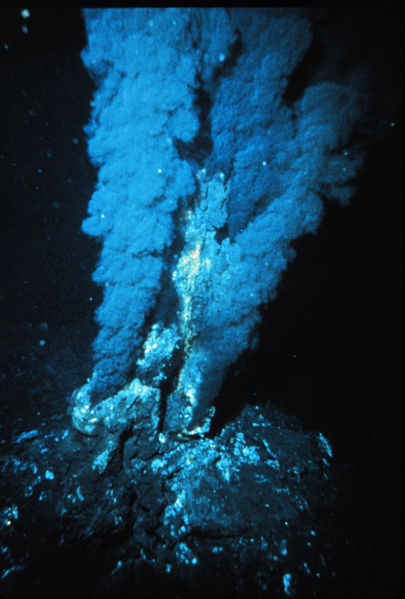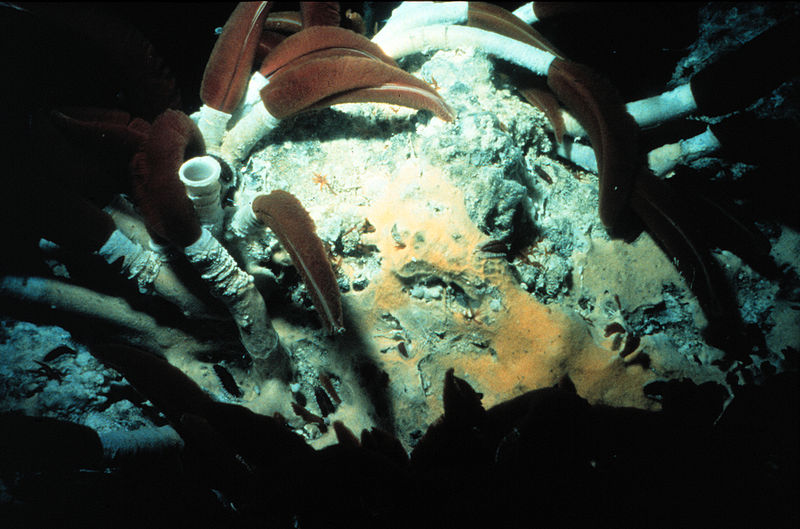Life at Hydrothermal Vents
Interview with
Diana - It's not just rock that can block sunlight: water does too, and you need only descend a few hundred metres to enter the aphotic zone - where sunlight is too weak for plants to photosynthesise. But there are other sources of energy on the seabed, and among them are hydrothermal vents, which harbour ecosystems found nowhere else on Earth. Professor Paul Tyler is from Southampton University, and works on understanding these systems. Hello, Paul.
Paul - Hi there.
Diana - So, can you just describe what the conditions are like down there underwater around these vents?
 Paul - The vents were discovered because scientists could not calculate the heat loss from the Earth without bringing in a convective part of it. What American scientists did in 1977 was go down and look for convective heat loss along the mid-ocean ridge that runs past the Galapagos Islands. And they found the convective heat loss with this hot water coming out of the seabed in temperatures between 200 and 300 degrees centigrade. But what really astounded them was the very, very luxurious communities of animals found around the hydrothermal vents compared to literally a few tens of meters off into the adjacent deep sea where there was virtually nothing living at all.
Paul - The vents were discovered because scientists could not calculate the heat loss from the Earth without bringing in a convective part of it. What American scientists did in 1977 was go down and look for convective heat loss along the mid-ocean ridge that runs past the Galapagos Islands. And they found the convective heat loss with this hot water coming out of the seabed in temperatures between 200 and 300 degrees centigrade. But what really astounded them was the very, very luxurious communities of animals found around the hydrothermal vents compared to literally a few tens of meters off into the adjacent deep sea where there was virtually nothing living at all.
Diana - So, what is the main source of energy for these life forms? What are they eating?
Paul - They're not really eating anything. The primary consumers are not eating anything. What's coming out of the hydrothermal vents besides hot water is a lot of hydrogen sulphide. Sea water, sulphate rich seawater percolates through the rocks of the seabed, it's heated by magma, comes out at a hydrothermal vent and that sulphate has been reduced to hydrogen sulphide. And it's the same process of chemosynthesis, that occurs in the caves of Romania, and we see this in the free-living bacteria surrounding the hydrothermal vents. But what was particularly clever at hydrothermal vents, there was a group of organisms called the tube worms and they had no gut - no mouth, no gut and no anus, but they contained a structure called the trophosome, the so-called eating body, which was packed full of bacteria, or should I say Archaea that underwent the process of chemosynthesis.
Diana - So how does this ecosystem come about in the first place? I mean, it sounds like there's a little bit of interdepency and how much of a system is it?
Paul - It's independent. You only find these systems at hydrothermal vents. There are related systems at areas called cold seeps, but what is so clever about some of the animals is the evolutionary process allows these tube worms to transport oxygen, carbon dioxide and hydrogen sulphide through their blood system, it's absorbed through their tentacles in the crown, to this trophosome where these bacteria are. Now, if you inject hydrogen sulphide into an animal, the chances are, you're going to kill it immediately, but there's an adaptation where the hydrogen sulphide is bound to a blood protein and stops it being toxic, and then it's taken through to the trophosome where the bacteria undergo the process of chemosynthesis internally within the animal and then they release organic matter. So, the animal itself is still a heterotroph. It is the bacteria that live within this trophosome within the animal that are autotrophic.
 Diana - I see. So they're making good use of their situation, but how different are these species to ones that we find, just every day, around the surface of the Earth?
Diana - I see. So they're making good use of their situation, but how different are these species to ones that we find, just every day, around the surface of the Earth?
Paul - Very different indeed. For a start, they're very specialised. The tube worms particularly are specialised, but there are a number of animal groups; you find large bivalves and there's a mussel that looks not unlike like the mussel you might find on the seashore around Britain. But it's a mussel that has these bacteria in its gill and so, it can take in hydrogen sulphide, CO2, and oxygen over the gill surface, and the bacteria produce this organic matter. So, that's just adapted to the hydrothermal vent. We find other bivalves do the same and if you come over into the Atlantic, there is a shrimp - I suppose you know when you eat shrimp in a restaurant, you tear off the head part and you eat the abdomen? Well, if you look at the main thorax of these shrimp in the Atlantic, they have bacteria growing underneath the carapace, the covering of the animal, and then they appear to take those bacteria off, and move them to the mouth for ingestion.
Diana - All right, so these bacteria are really getting around all of the species down there then, but why do we need to learn about these systems? Why are they important?
Paul - There's a number of reasons why they're interesting. Firstly, one of the interests has been, was this the cradle of life? Were these hydrothermal vents where the first molecules, shall we say, the first organic molecules were formed? That's an ongoing question that still remains a long way from being resolved of course. They might well have been refuges for life, if there was really a 'snowball earth' at one time. And also, they have some very interesting properties in terms of potential biotechnology. If these enzymes that are in these animals are working at slightly higher temperatures than normal, they might have some biotechnological use. But there's a lot of other scientific questions in terms of, these are relatively isolated spots along the midocean ridge. As a reproductive ecologist, I'm interested in how animals reproduce, disperse and colonise new hydrothermal vents, and that's been a really ongoing question about how these communities maintain themselves.
Diana - Almost like castaways. Well thanks, Paul. That was Paul Tyler from Southampton University.









Comments
Add a comment